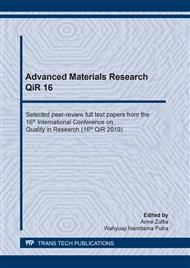[1]
M. A. D. Iqbal, A. S. Halimah, M. K, Abdullah, M. K. Zalifah, Fatty acid composition of four different vegetable oils (red palm olein, corn oil and coconut oil) by gas chromatography, IPCBE 14 (2011) 31-44.
DOI: 10.3923/pjbs.2011.399.403
Google Scholar
[2]
S. P. J. N. Senanayake, F. Shahidi, Structured lipids: acydolysis of gamma-linolenic acid rich-oils with n-3 polyunsaturated fatty acids. Journal of food lipids 4 (2002) 309-323.
DOI: 10.1111/j.1745-4522.2002.tb00228.x
Google Scholar
[3]
A.N. Suarez, M. Grahn, R. Pasaribu, R. Larsson, The influence of base oil polarityon tribological performance of zinc dialkyl dithiophosphate additives. Tribology International 43 (2010) 2268-2278.
DOI: 10.1016/j.triboint.2010.07.016
Google Scholar
[4]
N. J. Fox, G. W. Stachowiak, Vegetable oil-based lubricants – a review of oxidation. Tribology International, 40 (2007) 1035-1046.
DOI: 10.1016/j.triboint.2006.10.001
Google Scholar
[5]
N. J. Fox, B. Tyrer, G. W. Stachowiack, Boundary lubrication performance of free fatty acids in sunflower oil, Tribology Letters, 16 (4) (2014) 275-280.
DOI: 10.1023/b:tril.0000015203.08570.82
Google Scholar
[6]
G. W. Stachowiak, A. W. Batchelor, Engineering Tribology, 3rd edition, Oxford, (2005).
Google Scholar
[7]
A. Adhvaryu, S. Z. Erhan, J. M. Perez, Tribological Studies of thermally and chemically modified vegetable oils for use as environmentally friendly lubricants, Wear, 257 (2004) 359-367.
DOI: 10.1016/j.wear.2004.01.005
Google Scholar
[8]
Ryota, T. Ryo, S. Shinya, Effect of fatty acids on lubricity of vegetable oils, 15th International conference on experimental mechanics, Portugal, (2012).
Google Scholar
[9]
D. Gasni, H. I. Mulyadi, J. Affi, A. Y. Mswar, Investigation of wear mechanism in ball bearings lubricated by a bio-lubricant, Int. J. of Tech. 7 (2017) 1248-57.
DOI: 10.14716/ijtech.v8i7.688
Google Scholar
[10]
D. Gasni, H. I. Mulyadi, J. Affi, Comparison of Physical and Tribological Properties of Coconut Oils Extracted from Dry and Wet Processing, In Proceeding of Malaysian Tribology Conference, 217-19, (2015).
Google Scholar
[11]
J. A. Schey, J.A., Tribology in Metalworking: Friction, Lubrication and wear, American Society of Metals, Metal Park, OH (1983) 27-130.
Google Scholar
[12]
G. Biresaw, Elastohydrodynamic Properties of Seed Oils, JAOCS, 83 (6) (2006) 559-566.
Google Scholar
[13]
B. T. Hamrock, B. T., and D. Dowson, Ball bearing Lubrication: The Elastohydrodynamic of Ellipticac Surfaces, Willey, New York, (1981).
Google Scholar
[14]
M. Hanif, M. F. Wani, Effect of surface roughness on wear rate during running-in of En31-steel: Model and experimental validation, Materials Letter, 176 (2016) 91-93.
DOI: 10.1016/j.matlet.2016.04.087
Google Scholar


